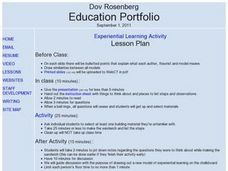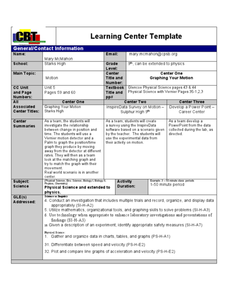Curated OER
Reading Portfolio
Students record their own voices using microphones, computers, and reading selections and chart progress at recognizing words, phonics, word structure, and context clues. This elementary lesson uses the computer program Timeliner.
Curated OER
Post Assessment: Student Illustrations and Writing About the Sun
Young scholars write about what they have learned about the Sun.
Curated OER
A Personal Reflection on the Canadian Parliamentary System and Its Delivery to Secondary Students
Students develop a newspaper portfolio of "Canadian Democracy At Work" and find examples of events/decisions/people from media sources to reinforce the concepts of Power and Authority in the Canadian context.
Curated OER
Student Illustrations and Writing About the Sun
Students discuss what they know about the Sun. The teacher distributes work sheets and asks students to draw the Sun and label any parts of it that they know. Students write what they know about the Sun.
Curated OER
Dov Rosenberg Education Portfolio
Students view several slides bulleted to explain what each author, theorist and model means. They draw similarities between all the models. The execution to make a peanut butter and jelly sandwich is then webbed out.
Curated OER
Map the Green Space
Students investigate the environment in their community by creating a presentation. In this environment lesson, students utilize cameras to document the green spaces in their community and the benefits they create for everybody....
Curated OER
Semester Writing Self-Evaluation
In this writing self-evaluation worksheet, students respond to 5 questions regarding their writing pieces and their goals as writers.
Curated OER
Mendel and Heredity
Students identify the investigator whose studies formed the basis of modern genetics (Mendel). They list characteristics that make the garden pea a good study organism, and summarize the 3 major steps of Mendel¿¿¿s experiment.
Curated OER
Classification, Keys, and Phylogenetci Trees
Learners analyze relationships about animals and create a model of classifications based on both the similarities and the differences. They also discuss a dichotomous key before they create a cladograph using different types of candy.
Curated OER
Illustration # 5: Phone Number Melodies
Fourth graders create their own melodies by making up a phone number with the numbers of the C major scale (the number 9 will be played by double the C at an octave. Students are encouraged to end their piece with V, I progression in...
Curated OER
Chemical Formulas
Learners assess how to go from writing ionic chemical formulas to nomenclature and naming chemical compounds. They brainstorm former studies and share their thoughts in small groups. A list of everyday products (shampoos, toothpaste,...
Curated OER
Ionic Chemical Formulas Days 1 & 2
Students study polyatomic ions and write binary and ternary ionic chemical formulas. They explore putting together different monatomic ions and coming up with as many chemical formulas as possible. They play a game similar to memory...
Curated OER
"Graphing Your Motion"
Students study the concepts of motion, velocity, and acceleration through graphing their own movement using LoggerPro. They explain the difference between speed and velocity using the weather vane example. They discover the difference...
Curated OER
Climographs
Students identify trends and characteristics of climate zones and specific places within. Then, they graph annual climate trends (primarily Temperature and Precipitation) and create, interpret and extrapolate information based on...
Curated OER
Yellow Journalism
Seventh graders investigate yellow journalism and how it affected public opinion and the government during the Spanish American War. They define key vocabulary words, and take notes during a teacher-led lecture. In pairs they read...
Curated OER
Unemployment
Twelfth graders evaluate the state of the economy and develop a definition for unemployment. In groups, they read an article about how the economy affects society and discuss how it affects them. Individually, they research the types...
Curated OER
Robert Frost Learning Stations
Students, while utilizing learning stations, read and analyze Robert Frost's poems from his "Frostiana" collection. They are encouraged to experience and explore poetry through different means via small groups. Within each station they...
Curated OER
Comparing The Odyssey and "The Lotus Eaters"
Ninth graders compare the development of text in Book 5 of "The Odyssey" to Alfred Lord Tennyson's poem "The Lotus Eaters." After discussing the comparison's of the two text within a group, they create an original piece of work or...
Curated OER
Shh! We're Writing the Constitution
Fifth graders research, examine and study about the three branches of the government and the contents of the Constitution including both the Articles and the Amendments. They create their own classroom constitution at the end of the unit.
Curated OER
Transformation
Students discover visual arts by participating in a sculpting activity. In this artistic expression lesson, students examine some of the more famous sculptures in world history by utilizing the Internet. Students utilize clay, paper...
Curated OER
Composition
Ninth graders, while looking and examining a photograph provided to them, write a composition that exemplifies the photograph with at least three of the five composition rules illustrated with 100% accuracy. The composition is the start...
Curated OER
Harlem Renaissance
Students investigate the African American culture in the 1920's and the Harlem Renaissance. They read and analyze poems written by poets of the Harlem Renaissance, listen to jazz music and identify the characteristics of the music, and...
Curated OER
Force and Motion Project
In this force and motion worksheet, students create a picture book and answer 7 questions on force and 12 questions on motion. There are 4 extra credit questions.
Media Smarts
Who's on First? Alcohol Advertising and Sports
Students examine how alcohol companies use sponsorship of sports to promote their products. They complete a survey, analyze the results, and research the sports sponsorship portfolios of five beer companies.

























